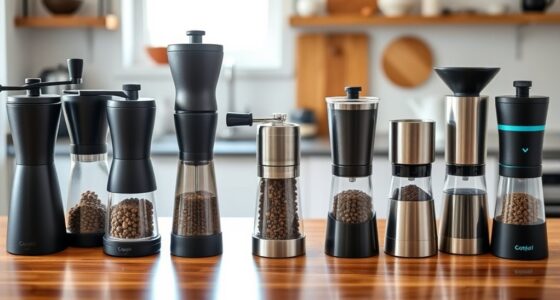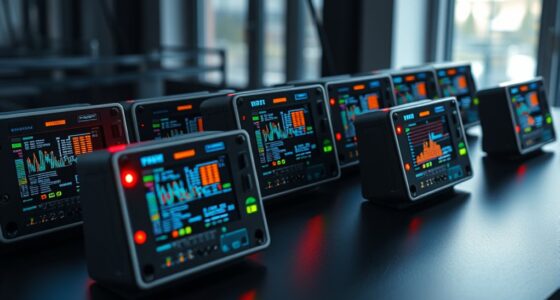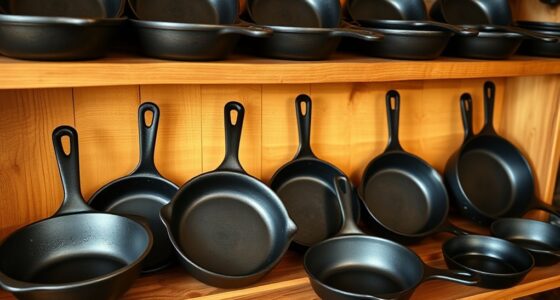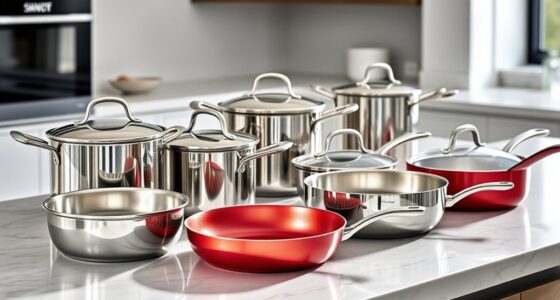If you’re looking to boost math learning and engagement, I recommend exploring a variety of top manipulative kits. These include options for early learners, elementary, and middle grades, with tools like foam shapes, counting cubes, fraction tiles, and number lines. These kits foster hands-on understanding of concepts like place value, addition, subtraction, and fractions. Keep exploring, as I’ll share detailed insights on each kit to help you make the best choice for your learner.
Key Takeaways
- The top kits include colorful, durable manipulatives like base ten blocks, fraction circles, and pattern blocks for varied math concepts.
- Suitable for early learners to middle elementary students, supporting skills from counting to decimals.
- They promote hands-on, visual, and kinesthetic learning, enhancing understanding of abstract math topics.
- Features like organized storage, activity cards, and wipeable mats facilitate easy, portable, and independent practice.
- Selecting the right kit depends on age, content focus, durability, and compatibility with classroom or homeschooling needs.
hand2mind Take Home Math Manipulatives Kit for Kids Grade K-2
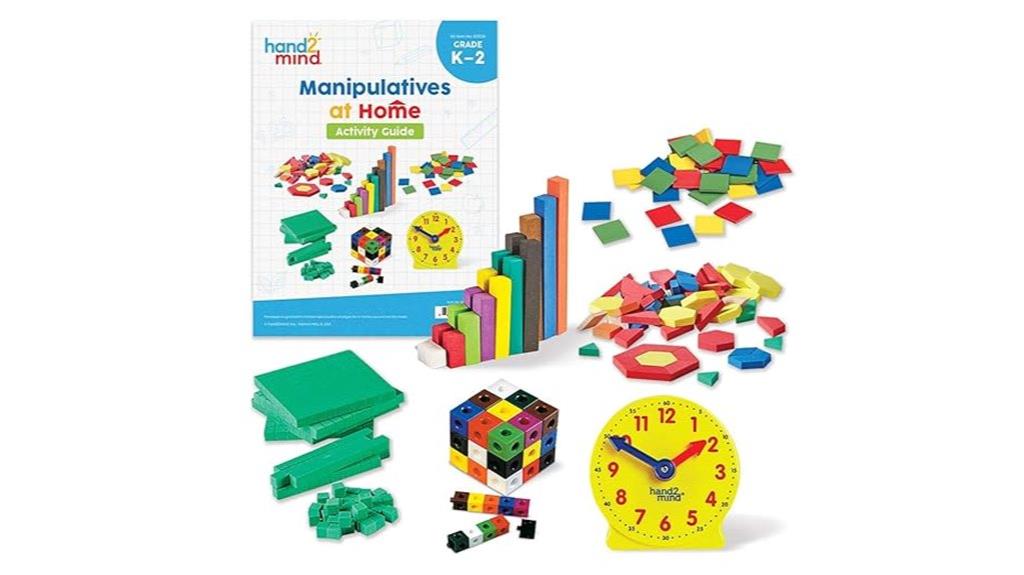
If you’re looking for an all-inclusive math manipulative kit designed specifically for young learners in kindergarten through second grade, the hand2mind Take Home Math Manipulatives Kit is an excellent choice. It offers 74 foam Cuisenaire rods, base ten units, rods, flats, plus pattern blocks, snap cubes, and a geared clock, all in one package. These tools make abstract concepts like addition, subtraction, fractions, and time tangible and engaging. The kit encourages hands-on exploration at home or in the classroom, helping children develop a deeper understanding of key math skills. Its durable design and easy-to-follow activities make learning both fun and effective for young students.
Best For: young learners in kindergarten through second grade, homeschooling families, and teachers seeking a comprehensive, hands-on math teaching resource.
Pros:
- Includes a wide variety of manipulatives such as foam rods, tiles, pattern blocks, snap cubes, and a geared clock, supporting diverse math concepts.
- Promotes tactile and visual learning, making abstract concepts like fractions, time, and operations easier to grasp.
- Durable, brightly colored materials designed for small hands, ensuring safety, longevity, and engaging hands-on exploration.
Cons:
- Some users note the plastic packaging may be excessive and less environmentally friendly.
- The kit is primarily designed for K-2, so older students may find the tools less challenging or versatile for advanced math.
- While comprehensive, some may find the quantity of items overwhelming or prefer more organized storage options.
hand2mind Math Manipulatives Kit for Grades 3-5
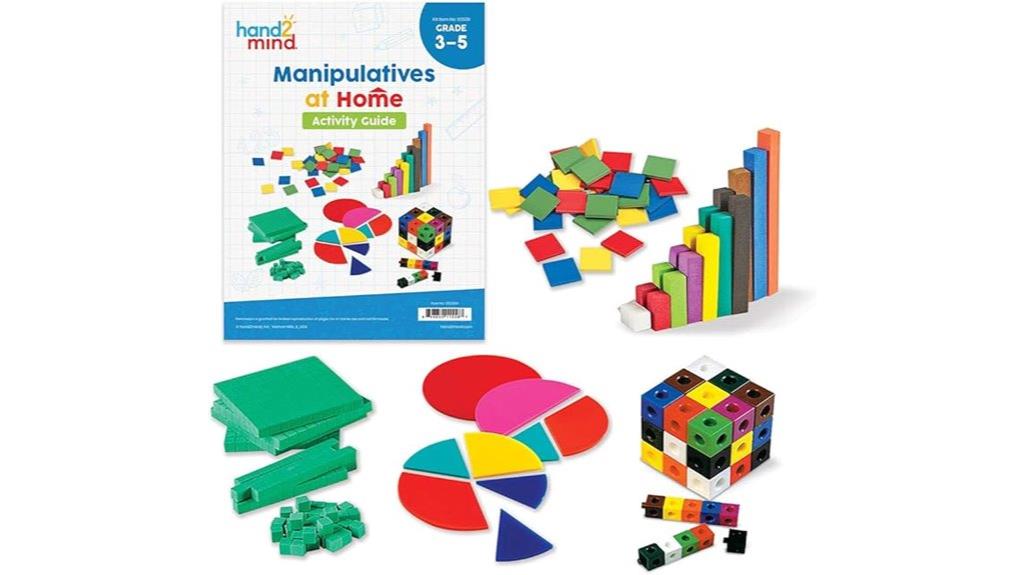
The hand2mind Math Manipulatives Kit for Grades 3-5 is an excellent choice for homeschooling parents and educators seeking an extensive set of tools to support middle elementary math instruction. It combines essential manipulatives like foam base ten blocks, counting chips, and cuisenaire rods, making it easy to teach place value, number relationships, and patterns. The 51 fraction circle pieces promote understanding of fractions visually, while the 100 linking cubes encourage pattern recognition and creative building. This all-in-one kit simplifies lesson planning, keeps students engaged, and supports a wide range of math concepts, making remote or in-person learning more effective and enjoyable.
Best For: homeschooling parents and educators seeking a comprehensive, all-in-one math manipulative kit for grades 3-5 to enhance remote and in-person math instruction.
Pros:
- Includes a wide variety of manipulatives such as foam base ten blocks, fraction circles, cuisenaire rods, and linking cubes, covering multiple math concepts.
- Simplifies lesson planning by providing an extensive, ready-to-use set of tools in one package.
- Supports engaging, hands-on learning that helps students better understand place value, fractions, patterns, and number relationships.
Cons:
- The large quantity of items may be overwhelming for some users to organize or store.
- Some manipulatives, like foam pieces, may wear out or get damaged over time with frequent use.
- The kit is tailored for grades 3-5, so it might not fully meet the needs of younger or older students without supplementary resources.
Take Home Math Manipulatives Kit for Kids Grade K-3

Designed specifically for children in grades K-3, the Take Home Math Manipulatives Kit offers a hands-on approach to building essential math skills. It includes a variety of tools like ten-frames, counters, tens rods, and pattern blocks that make abstract concepts tangible. I love how the kit supports understanding addition, subtraction, place value, and geometric shapes through engaging activities. Perfect for both classroom and home use, it helps kids develop confidence in math by making learning interactive and fun. This versatile set is an excellent resource for early learners to explore math concepts actively and build a strong foundation.
Best For: parents, teachers, and educators seeking an engaging, hands-on math learning resource for children in grades K-3 to build foundational skills.
Pros:
- Includes a comprehensive set of manipulatives like counters, ten-frames, and pattern blocks for versatile activities.
- Supports understanding of key concepts such as addition, subtraction, place value, and shapes through interactive learning.
- Suitable for both classroom and home use, promoting confidence and school readiness in young learners.
Cons:
- Might require additional guidance or lesson plans for optimal use by parents or educators unfamiliar with math instruction.
- Limited to grades K-3, so not suitable for older students needing advanced materials.
- The physical manipulatives may be lost or damaged if not properly stored or handled.
edxeducation Math Cubes Set of 100 Counting Blocks with 5 Shapes
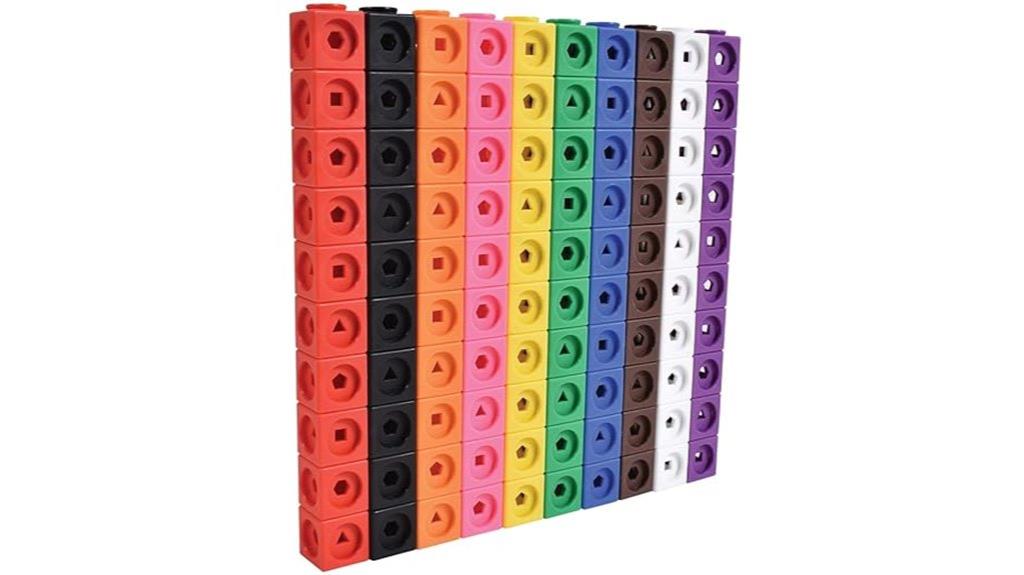
Looking for a versatile math manipulative that engages young learners through hands-on exploration? The edxeducation Math Cubes Set of 100 offers colorful, durable cubes with five shapes on each side—circle, square, triangle, pentagon, and hexagon. Kids can easily connect and disconnect the cubes, promoting fine motor skills, pattern recognition, and basic math concepts like counting, addition, and subtraction. The set’s bright colors and shapes support geometry and problem-solving activities, making learning both fun and educational. Ideal for classroom or home use, it encourages creativity, critical thinking, and STEAM exploration, providing endless opportunities for engaging math activities.
Best For: educators, parents, and children aged 3+ seeking an engaging, durable, and versatile math manipulative to support early math skills, geometry, and STEM learning through hands-on play.
Pros:
- Colorful, high-quality construction with secure linking for durability and repeated use
- Promotes fine motor skills, pattern recognition, and foundational math concepts like counting, addition, and subtraction
- Versatile for individual, group, and classroom activities, supporting a wide range of ages and curricula
Cons:
- Some users may find the cubes less sturdy compared to LEGO bricks for heavy construction
- Slightly higher price point relative to simpler counting blocks
- Occasional reports of missing pieces or minor quality inconsistencies in some sets
Carson Dellosa Be Clever Wherever Math Tool Kit for Grades 4-5
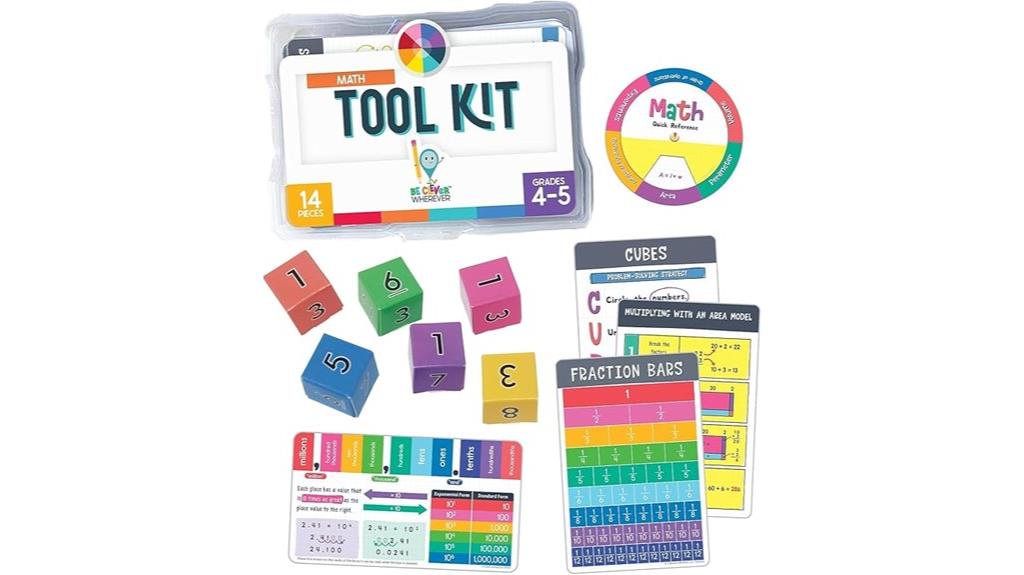
For fourth and fifth graders mastering essential math skills, the Carson Dellosa Be Clever Wherever Math Tool Kit offers a practical and engaging hands-on learning experience. This 30-piece set includes tools like a spin wheel, counting cubes, and double-sided charts, all stored in a portable case. It’s designed to reinforce key concepts such as multiplication, division, fractions, and problem-solving, making math accessible anywhere—at home, school, or on the go. The colorful manipulatives and reference materials help students understand abstract ideas through tactile learning, encouraging independent practice. Overall, it’s a versatile kit that promotes confidence and engagement in math.
Best For: Parents, teachers, and homeschoolers seeking a hands-on, portable math learning toolset for 4th and 5th graders to reinforce key concepts and foster independent practice.
Pros:
- Includes a variety of manipulatives and reference charts for interactive learning
- Portable and lightweight, making it easy to use anywhere at home, school, or on the go
- Supports multiple math skills such as multiplication, division, fractions, and problem-solving
Cons:
- Materials are functional but may be considered average in quality by some users
- Limited to basic math concepts, so may require supplementing for more advanced topics
- The set’s small size may be less comprehensive compared to larger, more detailed kits
Base Ten Blocks with Place Value Chart for Kids
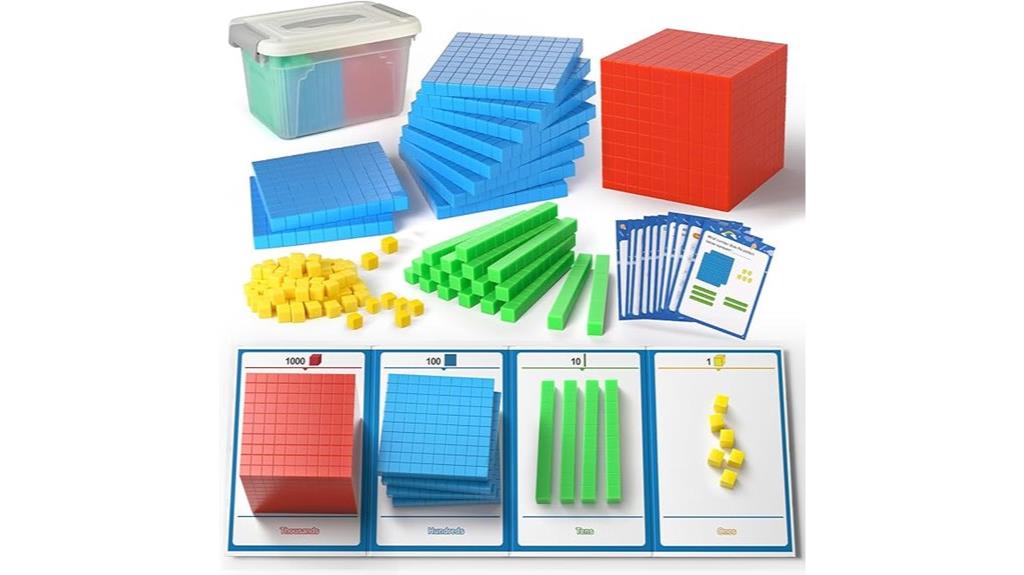
The Base Ten Blocks with Place Value Chart for Kids stand out as an excellent choice for elementary educators and homeschooling parents aiming to make math concepts tangible. I’ve found these sets incredibly effective for teaching place value, addition, and subtraction through hands-on activities. The variety of units, rods, and flats helps kids visualize number relationships and understand decimals. The durable plastic pieces are lightweight and easy to clean, making them perfect for young children. Plus, the included storage box and math cards support organized, engaging lessons. Overall, these blocks make abstract math ideas accessible, boosting confidence and curiosity in young learners.
Best For: elementary teachers, homeschooling parents, and caregivers seeking an engaging, hands-on tool to teach place value, addition, subtraction, and decimals to children from preschool to 4th grade.
Pros:
- Durable, lightweight plastic pieces that are easy to clean and handle for small hands.
- Includes organized storage, math cards, and a versatile erasable mat to support a variety of learning activities.
- Highly rated (4.7/5) by parents and educators for effectiveness, engagement, and quality.
Cons:
- Some users note that the large cube may have durability issues over time.
- The design of the block backs could be improved for better stability during use.
- Slightly higher price point compared to similar basic manipulatives, though often justified by quality and included accessories.
GOLDGE 360-Piece Math Set for Kids 3-8
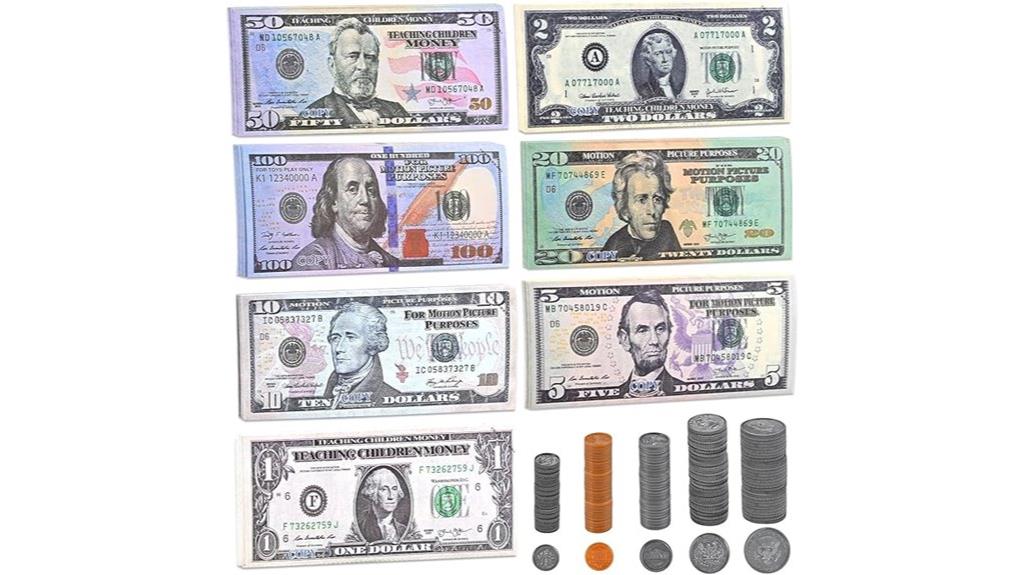
If you’re searching for a versatile math set designed specifically for young children, the GOLDGE 360-Piece Math Set for Kids 3-8 stands out as an excellent choice. This extensive kit includes colorful counting tools, plastic coins, and durable, tear-resistant paper, making it perfect for developing foundational math skills. Made from non-toxic, eco-friendly materials, it’s safe and built to last. The set encourages early financial literacy, counting, and cognitive growth while promoting parent-child interaction. It’s ideal for homeschool, classroom, or gift use, offering endless opportunities for engaging, hands-on learning that’s both fun and educational.
Best For: young children aged 3-8, parents, teachers, and caregivers seeking a comprehensive and engaging educational math set to support early learning and cognitive development.
Pros:
- Includes a wide variety of colorful, educational tools and durable paper components for versatile learning experiences
- Made from non-toxic, eco-friendly materials ensuring safety and long-lasting use
- Promotes early financial literacy, counting skills, and interactive parent-child bonding
Cons:
- The large number of pieces may be overwhelming for some children to organize initially
- Not specifically tailored for advanced math concepts beyond basic counting and money recognition
- Requires supervision to ensure small plastic coins are used safely with younger children
Learning Resources MathLink Cubes Set of 100
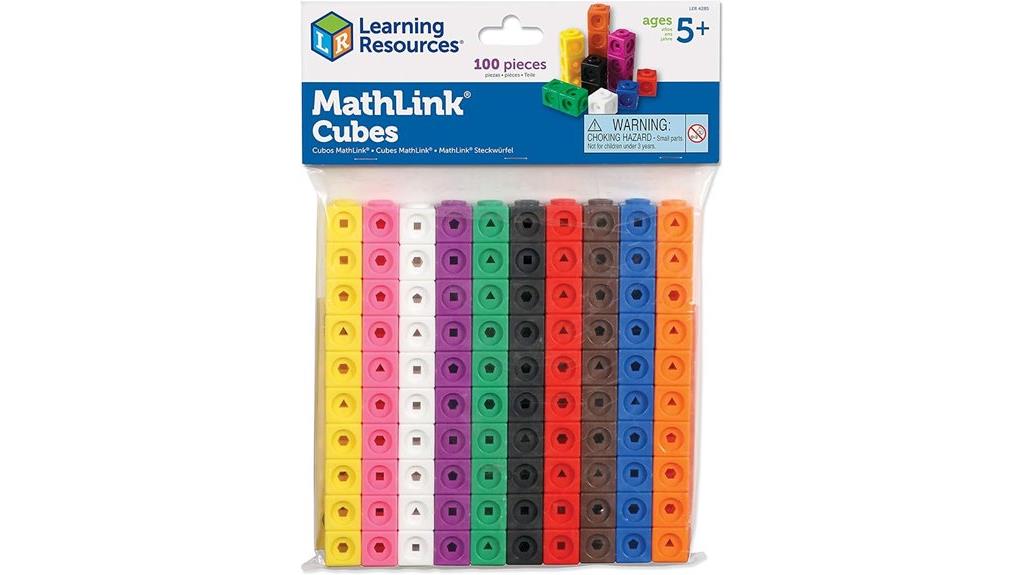
With 100 colorful MathLink cubes designed for children ages 5 and up, the Learning Resources MathLink Cubes Set offers an exceptional hands-on tool for early math learning. These durable, plastic cubes link on all sides and feature geometric shape cutouts, fostering patterning, shape recognition, and STEM skills. They support fundamental math concepts like counting, addition, subtraction, and measurement, while also enhancing fine motor skills, spatial reasoning, and problem-solving. Perfect for classroom or homeschool use, they encourage creative building and interactive lessons. With bright colors and easy connections, these cubes make math engaging, making them a versatile, long-lasting resource for developing early math and STEM abilities.
Best For: educators, parents, and caregivers seeking a durable, versatile tool to enhance early math and STEM skills for children ages 5 and up.
Pros:
- Supports a wide range of math concepts including counting, addition, subtraction, and measurement.
- Durable plastic construction with vibrant colors and geometric shape cutouts for engaging, hands-on learning.
- Compatible with other linking cube brands, making it adaptable for various classroom and homeschooling activities.
Cons:
- The weight and size of the cubes may be challenging for very young children under age 5.
- Limited to children aged 5 and up, so not suitable for preschoolers or infants.
- Some users might find the set’s focus primarily on basic math concepts less challenging for older children.
Torlam 131 PCS Base Ten Blocks for Math
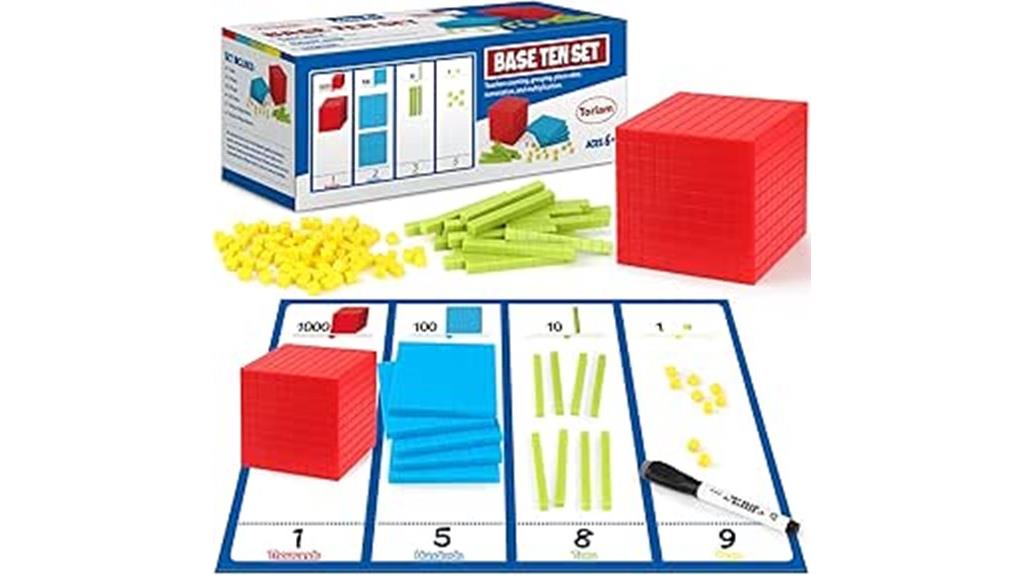
Designed specifically for early elementary students, the Torlam 131 PCS Base Ten Blocks set offers a hands-on approach that makes learning math concepts engaging and accessible. With colorful units, rods, flats, and a cube, students can explore place value, operations, decimals, and measurement visually. Created by teachers, this kit helps children develop number sense and logical thinking through building and solving equations. Made from durable plastic, the blocks are lightweight, easy to clean, and built to last. The included write & wipe mat and storage box support active learning and organization, making this set a versatile tool for classroom, homeschooling, or individual use.
Best For: early elementary students and teachers seeking a hands-on, visual tool to enhance understanding of place value, operations, and measurement in math.
Pros:
- Durable and lightweight plastic construction for long-term use and easy handling
- Includes a variety of colorful units, rods, flats, and a cube for comprehensive learning opportunities
- Comes with a write & wipe mat and storage box for active engagement and organization
Cons:
- May be too basic for advanced or older students seeking more complex math tools
- Requires additional instructional guidance for optimal use in teaching concepts
- Limited to elementary-level concepts, not suitable for higher-level math topics
Aizweb Magnetic Fraction Tiles & Circles for Classroom Teaching
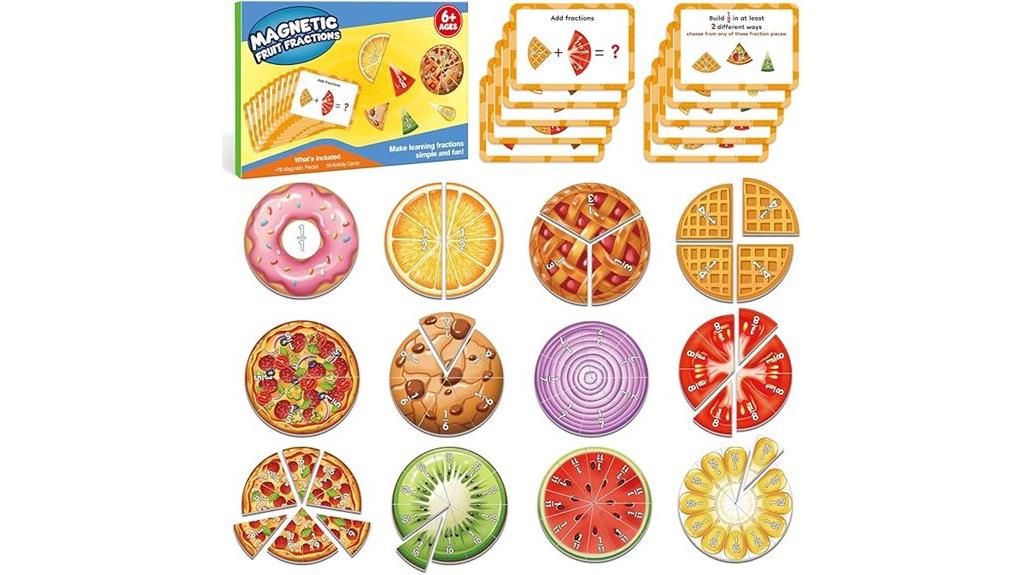
Aizweb Magnetic Fraction Tiles & Circles stand out as an excellent choice for elementary teachers and parents seeking engaging, hands-on tools to teach fractions. This complete set includes 12 colorful magnetic fraction circles and 10 activity cards, all featuring fruit-themed visuals that make learning fun. The magnetic design allows easy attachment to whiteboards or metal surfaces, encouraging interactive lessons. Kids can visually and tactilely explore fractions from whole to twelfth parts, fostering better understanding of addition, subtraction, and practical math skills. With vibrant graphics and versatile use, these manipulatives turn abstract concepts into engaging, concrete experiences for young learners.
Best For: elementary teachers and parents looking for engaging, hands-on tools to teach fractions to children in grades 2-5.
Pros:
- Bright, fruit-themed visuals make learning fractions fun and engaging
- Magnetic design allows easy attachment to whiteboards and metal surfaces for interactive lessons
- Supports visual and tactile learning, improving understanding of fraction concepts
Cons:
- Stickers on the tiles may come off easily over time
- Limited storage options, as the set does not include a storage bag or organizational accessories
- Some users find it challenging to store fractions together neatly
Torlam Magnetic Ten-Frame Set for Elementary Math
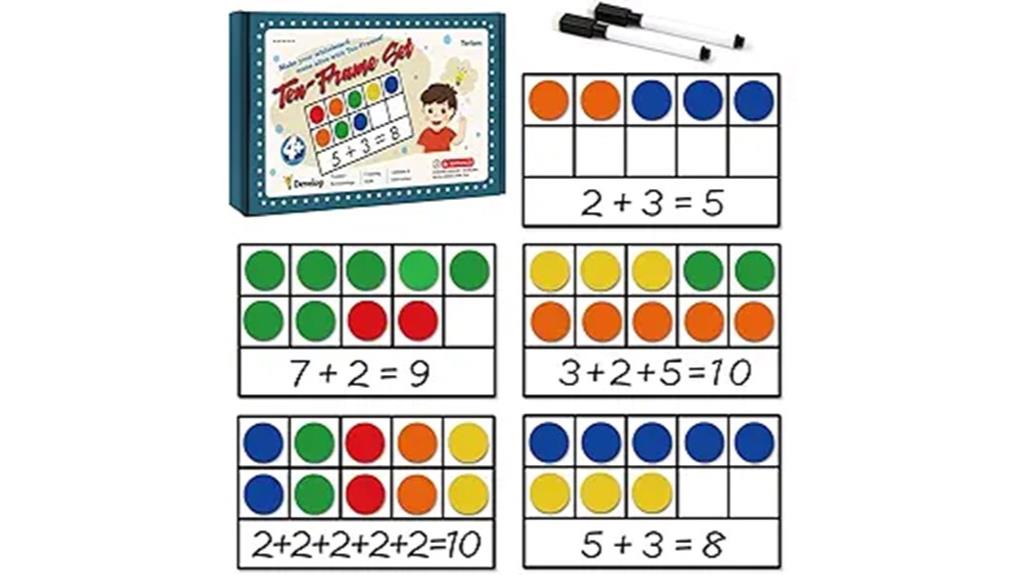
If you’re looking for a versatile tool to help young learners grasp essential math concepts, the Torlam Magnetic Ten-Frame Set is an excellent choice. It includes five ten frames and 55 magnetic counters, making it perfect for children aged 3 and up. The set boosts number sense, addition, subtraction, and more through hands-on activities that are both engaging and educational. Made with sturdy magnetic sheets and easy-to-handle discs, it supports classroom, small group, or individual work. Plus, the dry-erase trays add flexibility, allowing kids to model operations visually and demonstrate their thinking clearly. It’s a durable, high-quality set that makes learning math fun and effective.
Best For: educators and parents seeking a durable, versatile math manipulative to help children aged 3+ develop number sense, addition, subtraction, and other foundational math skills through engaging, hands-on activities.
Pros:
- Made with high-quality thick magnetic sheets and sturdy discs for long-lasting use.
- Supports multiple teaching methods with dry-erase trays and magnetic counters, enhancing interactivity.
- Suitable for individual, small group, or classroom use, making math concepts accessible and fun.
Cons:
- Some users report that the magnets may be slightly weaker than expected, requiring careful handling.
- The set’s size and number of pieces might be limited for very large classrooms or extensive activities.
- The magnetic strength might vary slightly between batches, affecting ease of use for some children.
SYNARRY Wooden Ten-Frame Math Manipulatives for Kids
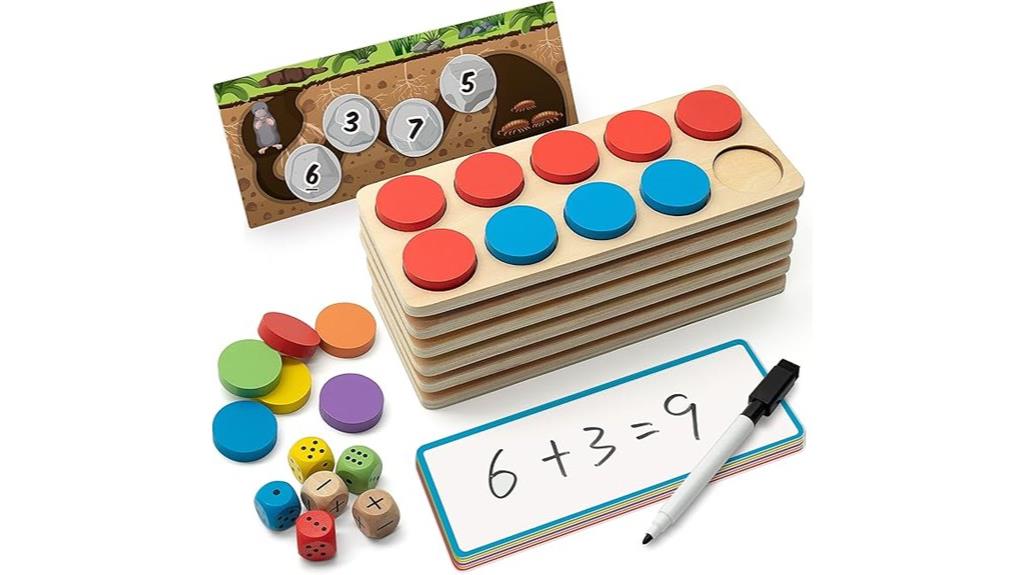
The SYNARRY Wooden Ten-Frame Math Manipulatives for Kids stands out as an excellent choice for homeschooling parents and elementary teachers seeking a versatile, hands-on tool to teach early math concepts. This set includes six wooden ten-frames, colorful counters, dice, number stones, dry-erase boards, markers, and game cards, all designed to enhance understanding of addition, subtraction, multiplication, and more. Its durable, FSC-certified wood guarantees safety and longevity, while the bright colors and engaging activities make learning fun. Suitable for children ages 3 to 10, it’s perfect for individual or group learning, fostering visual comprehension and active participation in math concepts.
Best For: homeschooling parents, elementary teachers, and tutors looking for a comprehensive, engaging math manipulative set to support early math skills and classroom activities.
Pros:
- Durable FSC-certified wood with safe, polished edges for long-lasting use.
- Bright, colorful components and versatile activities that make learning fun and engaging.
- Complete set including ten-frames, counters, dice, game cards, and dry-erase boards, suitable for a wide range of math concepts.
Cons:
- The counters are slightly on the smaller side, which may pose a choking hazard for very young children.
- The whiteboard erasers may require light water cleaning for thorough maintenance.
- Compact size, which is advantageous for space-saving but may limit the number of children using it simultaneously in larger groups.
edxeducation Transparent Counters Set of 500 Math Manipulatives for Kids

Designed for educators and parents seeking a versatile, large-scale math manipulative set, edxeducation’s Transparent Counters are ideal for engaging young learners in early math concepts. This set includes 500 bright, transparent counters in six colors, perfect for group activities, homeschooling, or classroom use. Measuring 0.75 inches, they’re safe, durable, and easy to clean, making them suitable for children aged 3 and up. Whether for counting, sorting, patterning, or demonstrating operations, these counters enhance visual learning and support inclusive education. Their resealable bag guarantees simple storage, making them a cost-effective, long-lasting resource for developing foundational math skills.
Best For: educators, parents, and caregivers seeking a large, versatile set of math manipulatives for young children to support early math skills and inclusive learning.
Pros:
- Includes 500 colorful, transparent counters ideal for group activities and individual learning.
- Made of durable, washable plastic with no sharp edges, ensuring safety and longevity.
- Comes in a resealable bag for easy storage and quick cleanup.
Cons:
- Some users find the counters smaller than expected, which may be less suitable for very young children or certain activities.
- Limited to six colors, which might restrict color-based sorting or advanced pattern activities.
- Not designed for very advanced math concepts, so may need supplementary materials for higher-level instruction.
Factors to Consider When Choosing a Math Manipulative Kit
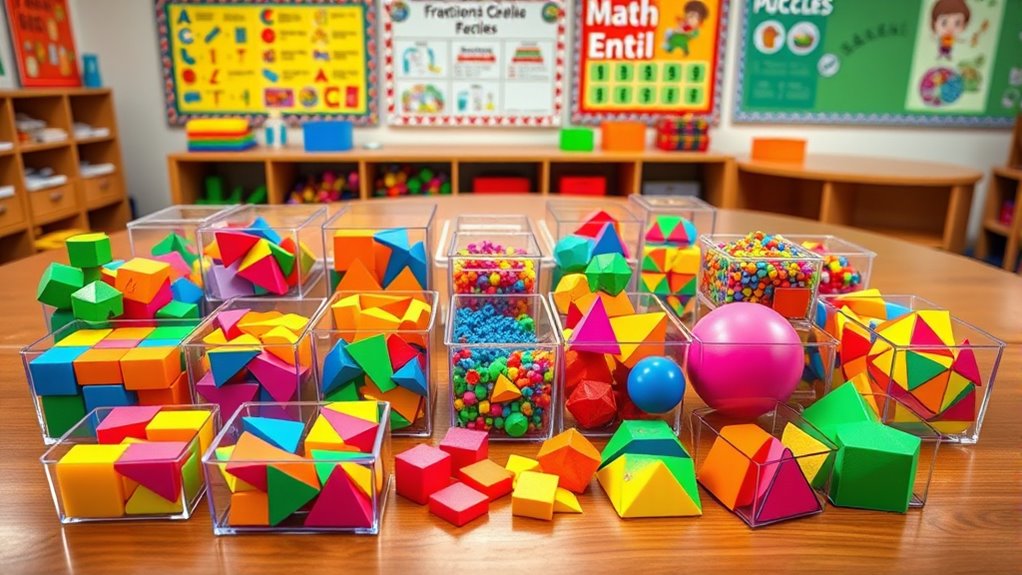
When choosing a math manipulative kit, I consider factors like age appropriateness and educational focus to guarantee it meets the child’s learning needs. I also look at durability and quality, so the materials last through active use, and I value a variety of materials to keep learning engaging. Finally, good storage options help keep everything organized and accessible for easy use.
Age Appropriateness
Choosing the right math manipulative kit depends heavily on the child’s age to guarantee they can learn effectively and stay safe. For younger kids ages 3-5, look for larger, soft, and non-toxic materials that are easy to handle and safe for exploration. Avoid small parts that pose choking hazards and ensure the kit is designed for their developmental level. For elementary children ages 6-10, opt for kits with more complex, smaller pieces that support fine motor skills and help them grasp advanced concepts. Always check product labels and recommendations to match the child’s age and curriculum needs. Selecting an age-appropriate kit not only enhances learning but also guarantees safety, making the experience enjoyable and productive for the child.
Educational Focus
Selecting a math manipulative kit that aligns with your child’s educational needs guarantees they receive the most out of their learning experience. I recommend considering the kit’s focus—whether it emphasizes foundational skills like counting, number sense, and basic operations, or more advanced topics such as algebra, geometry, or fractions. The right kit should support visual and tactile learning, helping children grasp abstract concepts through hands-on exploration. Additionally, think about whether the kit offers guided activities and instructional resources that reinforce key concepts. The educational focus should match your child’s current grade level and curriculum standards, ensuring the manipulatives are relevant and effective. By choosing a kit tailored to their specific learning goals, you set the stage for meaningful engagement and deeper understanding of math concepts.
Durability and Quality
Focusing on durability and quality guarantees that your child’s math manipulative kit remains a reliable educational tool through daily use. High-quality manipulatives are crafted from durable, non-toxic materials like thick plastic, foam, or wood, ensuring they withstand frequent handling. Well-constructed pieces feature reinforced joints, rounded edges, and sturdy components that resist breaking, cracking, or fading over time. The choice of materials also impacts cleaning; plastic and foam are often washable and resistant to stains, making maintenance simple. Durable manipulatives maintain their shape and vibrant colors even after extensive use, providing consistent learning experiences. Investing in quality not only extends the lifespan of the kit but also offers long-term value—saving you money while supporting your child’s ongoing educational growth.
Variety of Materials
A well-rounded math manipulative kit should include a variety of materials like base ten blocks, pattern blocks, counters, and geometric shapes to cover multiple learning concepts. This diversity supports different learning styles—visual, tactile, and kinesthetic—making math more accessible and engaging. Having a broad selection enables a wide range of activities, from counting and sorting to solving complex problems and constructing geometric figures. Including different textures, sizes, and shapes helps students explore mathematical relationships more deeply, fostering a better understanding of concepts. Additionally, variety encourages creative exploration, allowing students to make connections across topics. A kit with diverse materials ensures that learners stay motivated and can approach math from multiple angles, enriching their overall learning experience.
Storage and Organization
Having a variety of materials is important, but how you store and organize them makes a big difference in usability. Effective storage solutions like resealable bags or sturdy boxes keep manipulatives neat and accessible, making setup and cleanup easier. Clear containers or labeled compartments help students quickly identify and sort different types, boosting efficiency in the classroom or at home. Compact storage options are especially valuable in limited spaces, allowing you to maximize storage while still holding a wide range of materials. Durability is key, ensuring that containers withstand frequent handling and transportation without damage. Additionally, well-organized kits with designated sections support independent learning by enabling students to find and return materials easily, fostering responsibility and independence. Good storage truly enhances the overall effectiveness of a math manipulative kit.
Price and Value
When choosing a math manipulative kit, evaluating its price in relation to the number and quality of materials included is vital. I look for kits that offer a complete set of durable, high-quality manipulatives that can withstand repeated use, ensuring long-term value. It’s important to take into account whether the kit provides versatile tools that support multiple math concepts, maximizing educational benefits for the price. I also keep an eye out for any additional costs for accessories or replacements, as these can add up over time. Balancing affordability with the kit’s ability to meet specific learning needs helps me choose options that deliver effective, engaging math practice without unnecessary expense. Ultimately, a good value means getting the most educational benefit for the investment made.
Safety Features
Ensuring safety is a essential factor when selecting a math manipulative kit, as young children are naturally curious and may put objects in their mouths or handle materials roughly. I look for kits made from non-toxic, BPA-free, and child-safe materials to prevent health hazards. It’s imperative that all components have smooth edges and no small parts that could pose choking risks for young kids. I also verify that the set complies with safety standards like ASTM, EN71, or CPSIA, ensuring durability and safety compliance. Secure, sturdy connections are essential to minimize breakage and prevent sharp pieces from exposing dangerous edges. Ultimately, I choose age-appropriate pieces that are properly sized for the child’s developmental stage to avoid potential safety hazards.
Frequently Asked Questions
How Do Different Age Groups Benefit From Specific Manipulative Kits?
Different age groups benefit uniquely from specific manipulative kits. For young children, I find that simple counting blocks and shape sorters help develop foundational math skills and fine motor coordination. Older students gain more from fraction bars and algebra tiles, which make abstract concepts tangible. I encourage choosing age-appropriate kits to keep learners engaged and guarantee the activities challenge them just enough to foster growth without frustration.
What Safety Features Should I Look for in Math Manipulatives?
When choosing math manipulatives, I look for features like non-toxic materials, smooth edges, and sturdy construction to prevent injuries. I also check for secure closures and non-chokable sizes, especially for young children. Ensuring the manipulatives are free from sharp parts and harmful chemicals gives me peace of mind, letting kids confidently explore, experiment, and enjoy their learning without worry.
Can These Kits Support Remote or Hybrid Math Learning Environments?
Yes, these kits can support remote or hybrid math learning environments. I’ve found that kits with digital components or online-compatible resources make remote instruction easier. They often include digital activities, videos, or apps that complement physical manipulatives. This integration helps keep students engaged and allows me to facilitate interactive lessons even when students are learning from home. It’s a versatile way to enhance understanding regardless of the learning setting.
How Do Manipulatives Enhance Understanding of Abstract Math Concepts?
Manipulatives make abstract math concepts more concrete by allowing me to physically explore and visualize problems. When I use objects like blocks or counters, I can see patterns, understand relationships, and develop a deeper intuition. This hands-on approach helps me grasp ideas like fractions, ratios, and algebra more easily, making math less intimidating and more engaging. Manipulatives truly transform complex ideas into tangible experiences.
Are There Customizable Options for Different Learning Paces and Styles?
Yes, there are customizable options for different learning paces and styles. I love that many kits offer adjustable components or varied activity levels, allowing me to tailor lessons to each student’s needs. Whether they prefer hands-on, visual, or auditory learning, I can modify the materials or exercises to keep them engaged and progress at their own speed. These flexible tools truly help me meet diverse learning styles effectively.
Conclusion
Think of math manipulative kits as colorful keys opening the door to learning. With the right set, you transform tricky concepts into playful adventures that ignite curiosity and confidence. Whether you’re helping a young learner or expanding your toolkit, these kits are your trusty map and compass on the journey. Embrace the fun, and watch math become a vibrant part of every child’s story—ready to explore, discover, and succeed.


